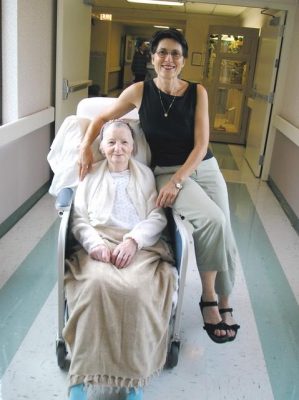The Voice of the Patient
by Loretta Downs
 My mother’s end-of-life was fifteen years long. It began the day my father died and she became involuntarily dependent upon her children to fill the roles he had played in her life throughout their 61-year marriage. We managed relatively well and her health continued to be good until 1998, when she was 86. Between that year and 2006 she spent two years in an independent living facility, and six years in a nursing home, made twelve trips to the emergency room, and was hospitalized five times.
My mother’s end-of-life was fifteen years long. It began the day my father died and she became involuntarily dependent upon her children to fill the roles he had played in her life throughout their 61-year marriage. We managed relatively well and her health continued to be good until 1998, when she was 86. Between that year and 2006 she spent two years in an independent living facility, and six years in a nursing home, made twelve trips to the emergency room, and was hospitalized five times.
Despite all these radical turning points in her health status and the opportunities they presented to open a conversation about our mother’s goals of care with the help and guidance of medical professionals, we did not. No one broached the subject.
Instead, we stumbled from crisis to crisis, tripping over our discomfort at using “The D Word” despite an obvious, progressive decline toward her inevitable death.
It was the 2005 Terri Schiavo case that brought my awareness to the potential tragedy awaiting us and gave me courage. My mother was 92 by then. One day we were together in her bed sharing a cup of coffee with ice cream in it, when I casually asked, “Do you ever think about the future, Mom?” She looked straight at me and replied, “I’m living my future.”
I gazed into her eyes, the same ones that define my face, and asked tentatively, “What if something happens to you and you can’t talk. What do you want us to do?” She slowly turned her head forward, stared at the wall covered in photos and greeting cards, and said softly, “You girls will know what to do.”
Not long after she was found unresponsive by an aide delivering lunch and was sent to the hospital. A few days into this semi-conscious state, an unfamiliar doctor took me into the hall and crisply said, “Your mother needs a feeding tube or she’ll starve to death.” I took a deep breath, let tears flow, and calmly replied, “Let’s call hospice instead.”
Within hours, a hospice nurse was at the hospital explaining what I might expect of the dying process and the services they would provide along the continuum. Mother was returned to her home at the Fairmont Care Center and I moved into her room with an air mattress to keep vigil. Three days later she sat up and asked, “Where’s my lunch?”
She thrived as a hospice patient. The added attention from the compassionate hospice workers, the nursing home staff and her family were sufficient reasons to “keep on going” as she liked to say. After three months she was discharged. Oddly, six months later the scenario repeated itself, the only difference being that when she was discharged, my mother was happy for the first time in her life. She had used her time in hospice, as had I, to make peace with her life. She told me she was happy.
Over the next four months we cared for her with massive doses of love and time and sweet treats. Then she had a stroke. In the emergency room her face and right arm were slack but her left hand gripped mine like a vise. She was afraid.
A doctor examined her and recommended admitting her to the hospital for tests but I refused, choosing hospice one more time. Mother let go of my hand. We returned to the Fairmont Care Center and moved into the Chrysalis Room I wrote about in the November issue of Hospital Newspaper where she was comforted, cared for by loving hands, and companioned by people she loved for eight days. She was home and ready to die.
Although I know I made the right decision for my mother, I wish she had been able to share her end-of-life decisions with me the way I am able to share mine with my health care proxy. What she and her children desperately needed in those fifteen years that marked my mother’s end of life, were crossing guards at every turning point who could ask us, “Do you ever think about the future?”
If you and I are going to receive the care we want at the end of our lives, we have to voice our choices. All of us – especially those who work in healthcare – need to lead by example. Make your healthcare decisions, talk often about your advance care plan, review and revise it every few years or when you experience a change in relationship to your Power of Attorney, move to another state, or get diagnosed with a life-limiting illness.
April 16, 2010 is National Healthcare Decisions Day. Use it as motivation to complete your healthcare directives. Use it as a reason to hold educational events in your communities. Use the resources at www.nhdd.org to help those who, like me, need someone like you to help them navigate the rugged road at the end of life.
Delivered at the Illinois Hospital Association Conference on November 17, 2010
